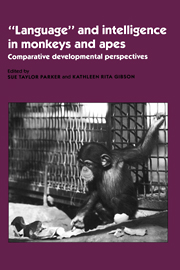Book contents
- Frontmatter
- Contents
- List of contributors
- Foreword
- Preface
- Acknowledgments
- Part I Theoretical frameworks for comparative developmental studies
- Part II Comparative developmental perspectives on cebus intelligence
- Part III Questions regarding imitation, “language,” and cultural transmission in apes and monkeys
- Part IV Developmental perspectives on social intelligence and communication in great apes
- 12 The emergence of intentional communication as a problem-solving strategy in the gorilla
- 13 “Social tool use” by free-ranging orangutans: A Piagetian and developmental perspective on the manipulation of an animate object
- 14 The development of peer social interaction in infant chimpanzees: Comparative social, Piagetian, and brain perspectives
- 15 Spatial expression of social relationships among captive Pan paniscus: Ontogenetic and phylogenetic implications
- Part V Development of numerical and classificatory abilities in chimpanzees and other vertebrates
- Part VI Comparative developmental perspectives on ape “language”
- Index
15 - Spatial expression of social relationships among captive Pan paniscus: Ontogenetic and phylogenetic implications
Published online by Cambridge University Press: 11 May 2010
- Frontmatter
- Contents
- List of contributors
- Foreword
- Preface
- Acknowledgments
- Part I Theoretical frameworks for comparative developmental studies
- Part II Comparative developmental perspectives on cebus intelligence
- Part III Questions regarding imitation, “language,” and cultural transmission in apes and monkeys
- Part IV Developmental perspectives on social intelligence and communication in great apes
- 12 The emergence of intentional communication as a problem-solving strategy in the gorilla
- 13 “Social tool use” by free-ranging orangutans: A Piagetian and developmental perspective on the manipulation of an animate object
- 14 The development of peer social interaction in infant chimpanzees: Comparative social, Piagetian, and brain perspectives
- 15 Spatial expression of social relationships among captive Pan paniscus: Ontogenetic and phylogenetic implications
- Part V Development of numerical and classificatory abilities in chimpanzees and other vertebrates
- Part VI Comparative developmental perspectives on ape “language”
- Index
Summary
Introduction
An exploratory study of a captive group of bonobos (Pan paniscus) was undertaken to describe the expression of social relationships through the utilization of space. The research objectives were to describe how the animals distributed themselves in the cage space, to describe spatial aspects of their social interaction, and to demonstrate a relationship between those phenomena. Distinctive patterns of spatial distribution, in fact, were observed for two subgroups of the population, and those distributions were reflected in the patterns of social approaches that members of the group adopted. The importance of space utilization resides in its ability to reflect stable social relationships, and thus dominance, in the virtual absence of aggression and overt gestures and signals.
The presence of a juvenile female in the group revealed a sharp contrast to the adult social space utilization. Her behavior indicated that although she reflected the female pattern of occupation of cage space, she had not yet begun to show the patterns of interaction consistent with social use of space. Adult interactions with her showed two distinctive patterns, one based on mutual avoidance and one based on use of overt gestures. The differential behavior shown by the adults among themselves, in their interactions with the juvenile, and by the juvenile herself suggest cognitive-based decisions. Inferences about cognition in ontogeny and phylogeny are tentatively drawn from the observed phenomena.
The social relationships among the bonobos are seen as a consequence of stable expression of dominance.
Information
- Type
- Chapter
- Information
- 'Language' and Intelligence in Monkeys and ApesComparative Developmental Perspectives, pp. 420 - 432Publisher: Cambridge University PressPrint publication year: 1990
Accessibility standard: Unknown
Why this information is here
This section outlines the accessibility features of this content - including support for screen readers, full keyboard navigation and high-contrast display options. This may not be relevant for you.Accessibility Information
- 3
- Cited by
